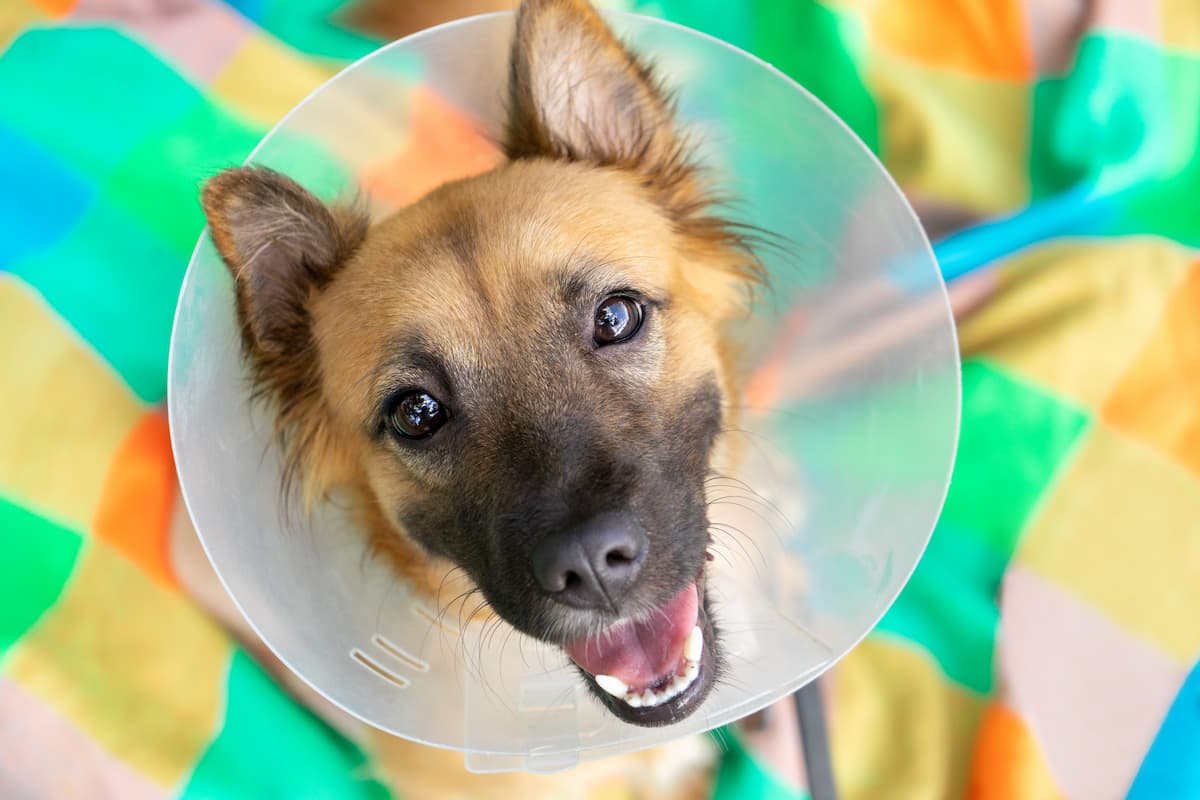As part of national desexing month, we’re sharing why desexing your dog is so important and what you need to know before you do it.
Desexing, also known as neutering or spaying, is a key part of responsible pet ownership but many of us are unsure about when to do it and if there are any possible health implications from the procedure.
So, let’s look at what desexing is and you need to know before you make that appointment.
What is desexing in dogs?
Desexing in dogs is a simple and standard procedure to remove a dog’s reproductive organs so that they cannot have puppies. In female dogs, we call it spaying and in male dogs, we call it neutering. We do it for a variety of reasons, including reducing the population of unwanted dogs that may end up in shelters or to reduce the risk of certain health problems like pyometra or mammary cancer in female dogs.
For male dogs, it can prevent testicular cancer and lower the chance of prostate problems. To learn more, visit the RSPCA’s guide on desexing.
Desexing can also improve your dog’s behaviour. Male dogs that are neutered are usually less aggressive, do better with other dogs, and less likely to roam away from home or pee in the house.
Female dogs that are spayed won’t go into heat, which stops behaviours like frequent urination and loud barking. It also means you don’t need to deal with messy discharge when a female dog is in heat or have all the intact male dogs in the area trying to get into your home.
But what is the difference between neutering and spaying?
Desexing differences between male and female dogs
Desexing is different for male and female dogs. For males, it’s a simple surgery to remove the testicles, and they recover quickly. For females, it’s a bit more complex because it involves removing the ovaries and sometimes the uterus. This means a longer recovery time and more care after the surgery.
Now, there are some pros and cons of desexing in canines that it’s worth considering before you
How much does it cost to desex a dog in Australia?
On average, you can expect to pay around $440 for spaying a female dog, and around $260 for neutering a male dog. However, the cost can be higher for larger breeds or if there are complications, with prices ranging up to $900 for spaying an extra-large breed.
Neutering is generally cheaper because it’s less invasive than spaying, but if a male dog’s testicles haven’t descended, the procedure can be more complicated and costly.
Pros and cons of desexing dogs
Let’s look at some of the advantages and disadvantages of spaying or neutering your dog.
Pros
- Desexing helps control the pet population by preventing unwanted litters.
- It can prevent serious health problems in both male and female dogs. This includes mammary tumours, pyometra (infection in the uterus), and testicular cancer.
- It can reduce aggression, roaming, and other unwanted behaviours.
Cons
- Like any surgery, there are risks such as reactions to anaesthesia and post-surgery complications.
- Desexing can change your dog’s hormones, which might affect their weight if not managed properly. It can also lead to complications like urinary incontinence in older female dogs as without oestrogen they can develop bladder sphincter and valve laxity over time.
- Once done, the procedure can’t be reversed, so it’s an important decision to make.
Possible surgical complications & considerations before desexing
Desexing is a common and generally safe procedure, but like any surgery, it comes with some risks. It’s essential to speak to your vet about any genetic issues that might make your dog vulnerable during surgery.
Certain breeds, like Greyhounds, can have specific anaesthesia sensitivities. Additionally, some dog breeds are prone to blood clotting disorders, such as the Doberman, which can suffer from von Willebrand’s disease. This can cause bleeding problems during surgery.
In very rare cases, a small piece of ovary tissue can be left behind, causing ovarian remnant syndrome. This means your female dog could come into heat again several months after surgery and may need a second surgery. However, this is very rare.
In general, it’s best to never spay your female dog during a heat as this is more likely to cause complications. If your dog is in heat, it’s best to spay her afterwards as soon as possible. But keep in mind, that with every heat your dog has, the chances of getting mammary cancer increases. This is why many vets prefer to spay a female dog before her first heat.
Discussing these potential problems with your vet is crucial to mitigate risks and ensure a safe procedure.

What’s the right age to desex your dog?
Deciding when to desex your dog is an important consideration for responsible pet ownership, and it can sometimes be a controversial one. The timing can affect your dog’s health and development, so it’s crucial to understand the best age for the procedure. Here’s what you need to know about choosing the right time to desex your dog.
General guidelines
While opinions on the ideal age to desex a dog can vary, most veterinarians agree on some general guidelines:
- For smaller breeds, it’s often recommended to desex between 6 and 9 months of age. These dogs mature faster, and early desexing can help prevent unwanted behaviours and health issues.
- For larger breeds, waiting until they are older, typically between 12 and 18 months, can be beneficial. This allows their bones and joints to develop fully, reducing the risk of orthopaedic problems.
Health considerations
The timing of desexing can impact your dog’s long-term health. Here are some key factors to consider:
- Early desexing (before 6 months) can prevent certain cancers and infections, such as testicular cancer in males and uterine infections in females.
- For large breeds, delaying desexing can support proper growth and joint development, potentially reducing the risk of hip dysplasia and other joint disorders.
- Early desexing can reduce aggressive behaviours and the urge to roam in search of a mate, contributing to a calmer and more manageable pet.
Breed-specific recommendations
Certain breeds have specific considerations when it comes to desexing:
- Research suggests that desexing certain larger breeds (such as German Shepherds, Golden Retrievers and Labrador Retrievers) after they reach one year of age may lower the risk of joint disorders, craniate cruciate ligament (CCL) injuries, and certain cancers.
- Toy breeds mature quickly, so desexing between 6 and 9 months is typically safe and effective.
Ultimately, it’s best to speak to your vet if you have any concerns about when you need to desex your dog, as the ideal time can differ, depending on the breed, size, or other health factors for your individual canine.
Before your dog’s surgery
Preparing your dog for surgery involves a few important steps:
- To ensure your dog’s stomach is empty during surgery, they should not have any food or water after 8 PM the night before the procedure.
- Have a thorough discussion with your vet about your dog’s health history and any concerns you might have.
- Bring along your dog’s favourite blanket or toy to help them feel more comfortable during their stay at the vet.
What to expect when you pick your dog up after surgery
When you pick up your dog after the surgery, expect them to be groggy from the anaesthesia. They might be disoriented and sleepy for the rest of the day. Your vet will provide specific instructions on how to care for your dog during the initial recovery period, including any medications that need to be administered.
Recovery time
- Most dogs will start to feel better within a few days. In fact, they should be acting normal within a day or two. If they are sluggish, refusing to eat, or acting abnormal after the first 24 to 48 hours, make sure to call your vet.
- Full recovery typically takes about 10 to 14 days.
- During this time, restrict your dog’s physical activity to prevent complications like wound reopening. They will often need to wear a cone to stop them licking or biting their stitches.
What to watch out for after the operation
After your dog’s surgery, keep an eye on the following signs that might indicate complications:
- Some swelling is normal, but if the surgical site appears very red or swollen, it might be infected.
- Any discharge from the surgical site, especially if it’s foul-smelling or coloured, should be checked by a vet immediately.
- While some tiredness is expected, prolonged lethargy could indicate a problem.
- It’s normal for your dog to eat less the first day or two, but if they refuse food for more than 48 hours, consult your vet.
- These can be side effects of anaesthesia or pain medication, but persistent symptoms should be evaluated by a vet.
Taking care of your dog after surgery is very important. Keep your dog calm and limit their physical activity to prevent problems. Check the surgery site for signs of infection and follow your vet’s advice on pain management and wound care.
You can find more information in Mad Paws’ article on how to care for dogs after surgery.
_________
Desexing your dog is a responsible choice that can improve their life and help control the pet population. By understanding the benefits and what to expect, you can make the best decision for your dog’s health and happiness.
We hope these insights help you make an informed decision during national desexing month and beyond.
